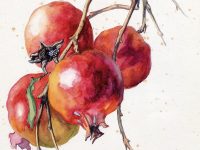Family orchards and vegetable plots in the Catalan Pyrenees play a key role in conservation and management of biodiversity and preservation of traditional knowledge. They also help enhance social cohesion and welfare while, at the same time, affirming cultural identity.
One need not go too far back in time to find oneself in the epoch when vegetable plots were the only source of fresh vegetables for the Pyrenean inhabitants. Every village was surrounded by these plots, which sketched a landscape of terraces, stretching along the sunny slopes, shunning the dank river plains shadowed by the surrounding peaks. The steep slopes did not prevent our recent ancestors, accustomed as they were to physical exertion, from making use of the land at unexpected heights. The boundaries to cultivation, in time and space, were set only by the crop’s lifecycle and its resistance to the cold.
«In so-called subsistence farming, all households had a vegetable garden or numerous plots where all the plants they needed were at hand, while other plots were planted with forage for livestock»
The economic and social changes over the past century dramatically affected the mountain areas due to depopulation and changes in land use. Today’s vegetable plots are the heirs of these trends, and this is the context in which our project with ethnobotanical roots1 is framed –funded by the Spanish Ministry of Science and Innovation (MICINN)–. This project had the general objective of studying family vegetable plots in mountain areas of the Iberian Peninsula and was conducted between 2008 and 2010, with the specific aim of studying conservation of agricultural biodiversity and preservation, transmission and innovation of plant lore. The results that follow, relate only to the Catalan Pyrenees.
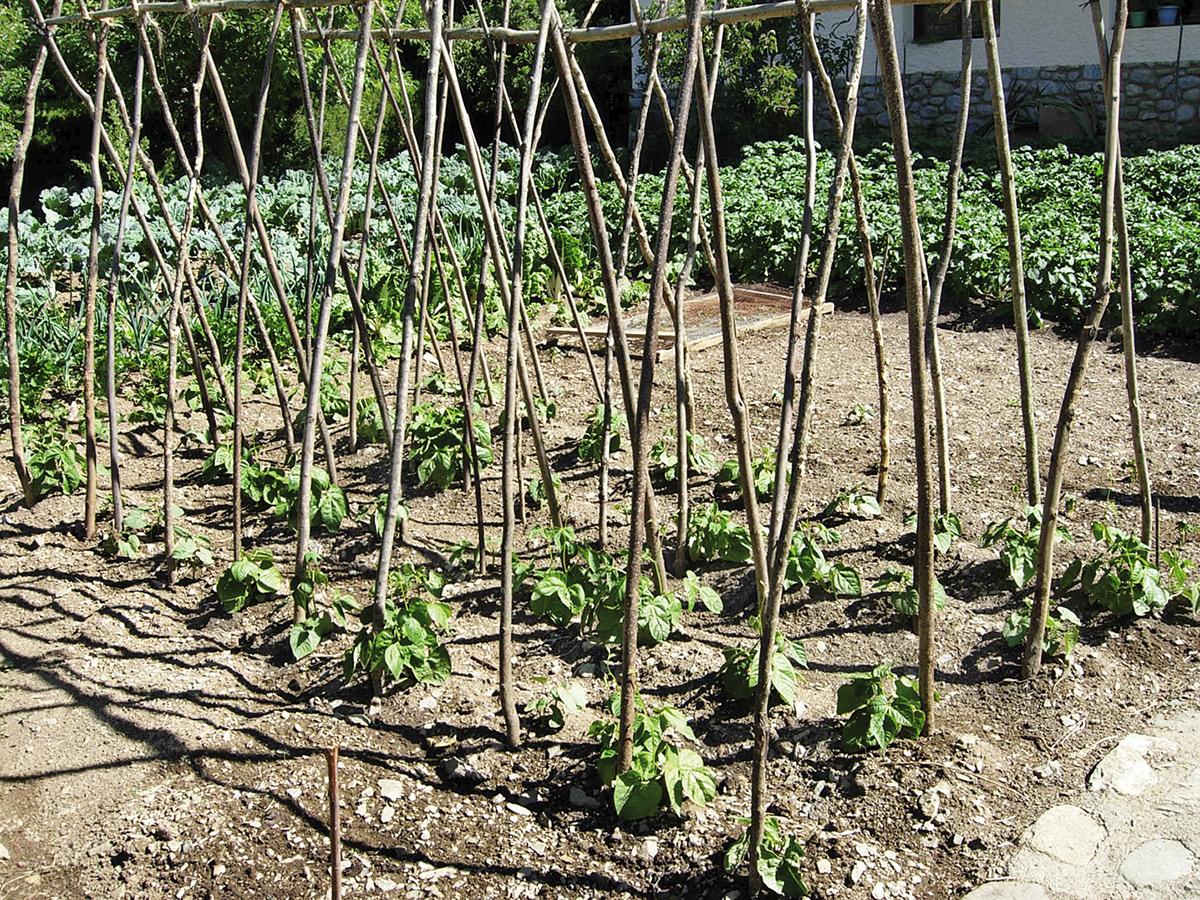
© T. Garnatje
THE CHANGING ROLE OF VEGETABLE PLOTS: FROM OBLIGATION TO DEVOTION
The Pyrenean vegetable plots and orchards are generally small plots, with an average area of around 360 m2, of which only around 280 m2 are cultivated. At the easternmost point of the mountain range, and with decreasing altitude of the terrain, the plots increase in size and the species we find are typical of the lowlands, which on reaching the plain of Alt Empordà, turn into typical orchards (Parada and Vallès, unpublished results).
In so-called subsistence farming, all households had, or still have, a plot, or even several vegetable gardens and orchards. All the plants they needed were at hand, growing in the plot beside the house, where a «bit of everything» was to be found. The woman of the house would further enrich the highly diverse plant collection growing in her vegetable plot –harbouring some species per garden– with medicinal and ornamental plants, thus adding to the usual horticulture species. The other plots, usually further away, tended to be larger and less diverse, not just cultivated by women, and they usually had a section devoted to livestock forage (Rigat et al., 2009). Nowadays, these vegetable gardens and orchards are still essentially tended manually and fertilisers are of organic origin, with the exception of commercial chemicals used in moderation, especially to combat certain pests.
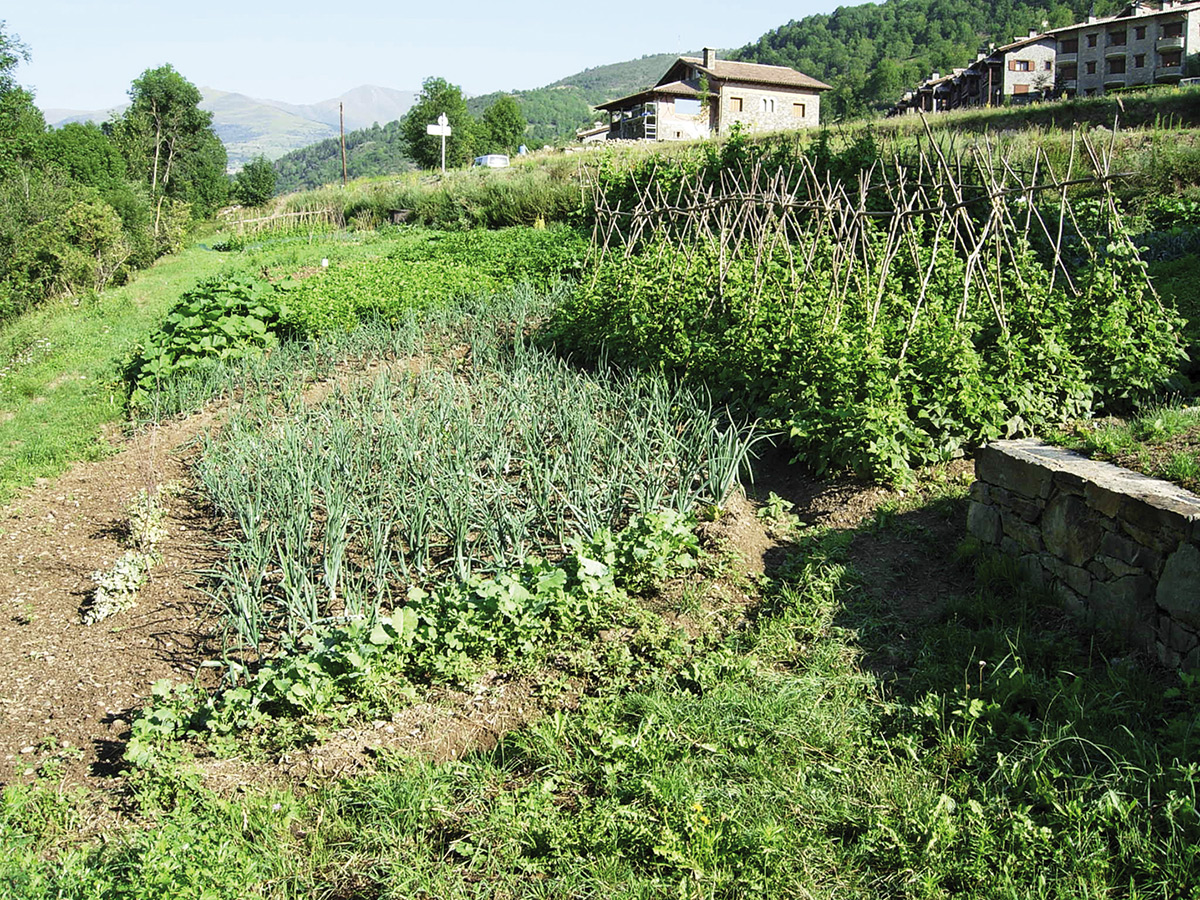
The pictures show a vegetable plot in the Alta Vall del Ter (Girona) tended by the owners, mostly retirees. / © L. Calvet-Mir
The plants grown in these plots can be classified into several categories according to usage. Needless to say, vegetables occupy the larger part of the area. Some of these species, such as rye (Secale cereale), have become less important over time, while others remain the basis of common dishes, such as winter cabbage (Brassica oleracea), a basic component of trinxat and canamillana, typical dishes of Cerdanya and the Ter and Freser region. Other frequent species are potato (Solanum tuberosum), courgettes (Cucurbita pepo) or beans (Phaseolus vulgaris), the latter with many local varieties (Calvet-Mir et al., 2011).
«The future of vegetable plots –as we know them in the Pyrenees– is quite uncertain. Changes in lifestyle, the impact of tourism –especially the construction of second homes– and migration to the city, will probably eradicate this type of plot»
Fruit trees are also an important component of these plots. The most common are the apple (Pyrus malus) and pear (Pyrus communis), along with several species of Prunus. Among the plants growing in these plots one must also include those used for cooking or seasoning, like parsley (Petroselinum crispum) or rue (Ruta chalepensis), traditionally used to put in chocolate. Another category is the one comprising medicinal plants. This includes plants used for treating adults and children for common ailments: chamomile for stomach ache (Achillea ptarmica subsp. pyrenaica at higher altitudes, Matricaria recutita or Santolina chamaecyparissus at the lowest), lily for burns (Lilium candidum) or marshmallow roots (Althaea officinalis) for colds, to name a few. No less important is the area devoted to ornamental plants –sometimes more abundant in species number than vegetables– scattered along the garden banks or areas less suitable for growing crops. Ornamental plant diversity is rising and may include truly exotic plants for our region. Previously, some were planted for religious purposes, such as pinks (Dianthus sp.) or chrysanthemums (Chrysanthemum sp.).
One must not forget another kind of plant which, although they may have no use for gardeners, can also be found in the vegetable gardens despite having suffered a major decline in recent years because of increased herbicide use. These are weeds, plants that grow wild among the crops and around the orchard borders and which used to be pulled up by hand. Some of them have been replaced by other species that come mixed in with commercial seeds or soils, which may be much more invasive. Some common weeds are purslane (Portulaca oleracea) which, despite being edible –it is even sold as such on some markets, like in Figueres– overruns certain crops, as do nettles (Urtica urens) or fleabane (Erigeron annuus), introduced from central Europe.
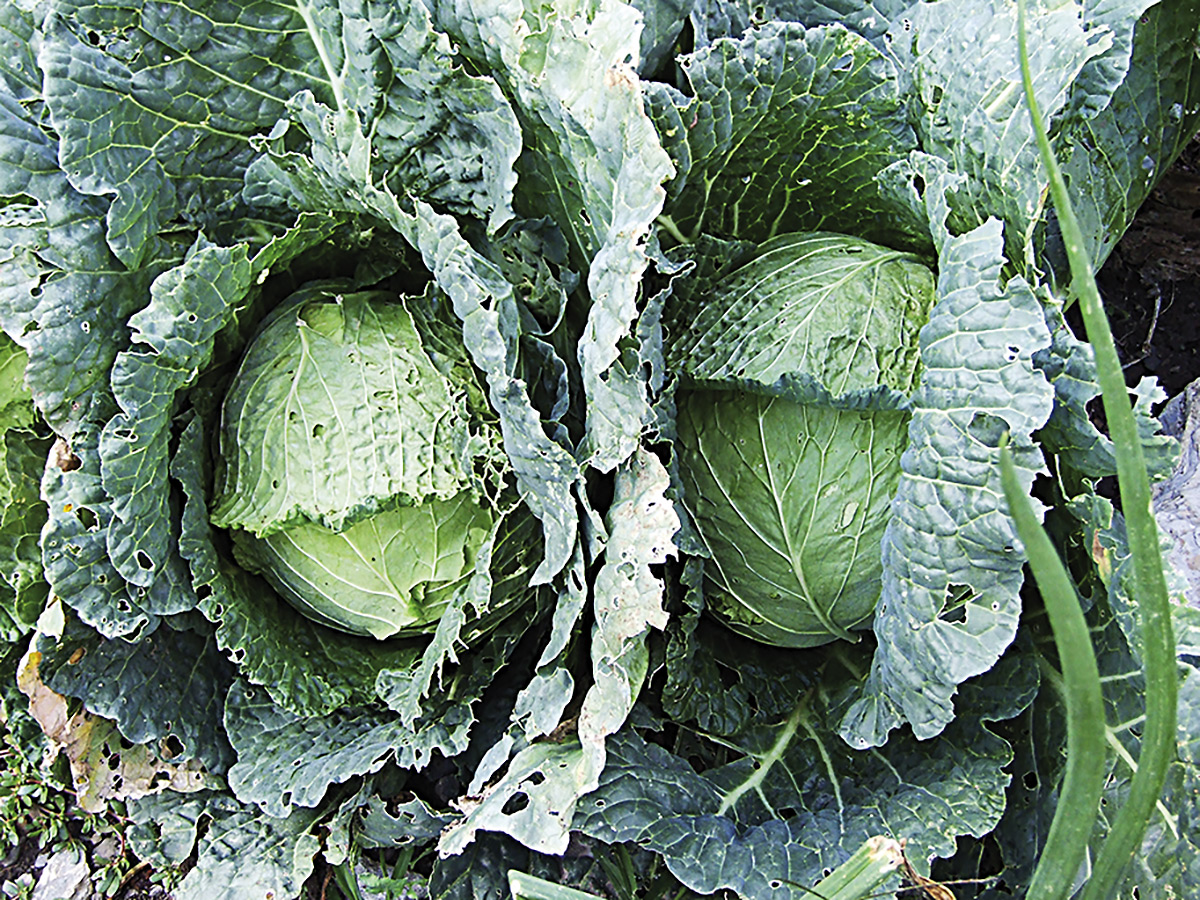
Winter cabbages in a vegetable plot in La Vall Fosca (Pallars Jussà). Common crop in Pyrenean vegetable gardens. / © L. Calvet-Mir
We have not set out to make an exhaustive list of plants currently growing in the plots and orchards here, this has already been done in our previous publication (Rigat et al., 2011), but we have to say that many of the species that were formerly in vegetable plots and orchards have now been replaced by commercial varieties. Indeed, traditional ones, whose seeds were kept year after year by gardeners for replanting, are no longer common. The proximity of markets and availability of allochthonous species has allowed alien plants into the plots and orchards, species that had never been heard of in our lands, some of which have not been too successful. We speak of plants such as the kiwi (Actinidia chinensis) or watermelon (Citrullus lanatus), which hardly bear quality fruit in the short Pyrenean summer. Sometimes more productive or pest-resistant species have replaced other native species with better organoleptic qualities, which are traditionally more highly appreciated in the region (Parada et al., 2011).
«Many of the species that were formerly in vegetable plots and orchards have now been replaced by commercial varieties. Indeed, traditional ones, whose seeds were kept year after year by gardeners for replanting, are no longer common»
In the more remote areas of the Pyrenees, shielded from the impact of tourism, one may still find the truly traditional vegetable plot, although both the profile of the gardener and the role of the plot have changed over time. Thus, the plots in the Pyrenees are worked by men and women, with an average age exceeding the age of retirement, who often did not continue studying beyond primary education. Approximately 67% of the people who tend a garden said that they do it mainly as a hobby. Only 33% said they also kept a garden for economic reasons, although the profits from the orchards may be relevant in some cases (Reyes-García et al., 2012).
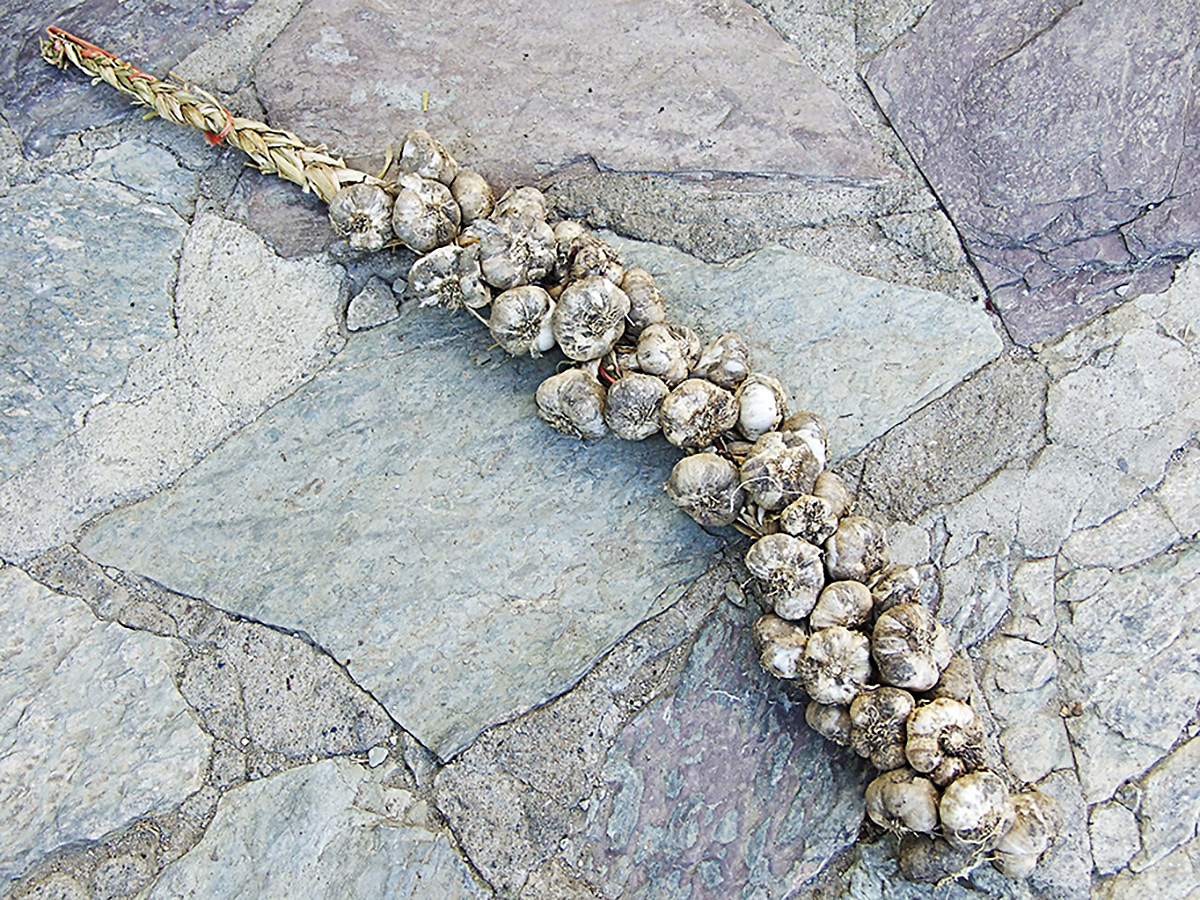
String of garlic. Common crop in Pyrenean vegetable gardens. / © L. Calvet-Mir
THE FUTURE OF VEGETABLE PLOTS AND PLOTS OF THE FUTURE
The preliminary results of our study into vegetable gardens in temperate regions have made us reflect on the need to go into greater depth, and thus we have drawn up a second project –recently awarded funds by the MICINN–. This time we will be focusing on edible plants in the same territories. Vegetable plots do not just play an important role in improving one’s quality of life by providing healthy food and exercise, as many of those participating in our study pointed out, but they also help gardeners to maintain social networks, exchanging seeds and knowledge, thereby contributing to social cohesion and strengthening cultural identity.
The future of vegetable plots –as we know them in the Pyrenees– is quite uncertain. Changes in lifestyle, the impact of tourism –especially the construction of second homes– and migration to the city, will probably eradicate this type of plot. In contrast, other new kinds begin to appear, such as urban vegetable gardens or allotments, with very different characteristics from those we have known so far. However, despite an evident loss of biodiversity and genetic variability, probably also linked to the loss of traditional knowledge, evolution seems to be leading to another kind of plot. This new plot has fewer local and more exotic varieties and their purpose is increasingly related to the physical and mental wellbeing of those who tend them, rather than that of food subsistence. The model for future plots or allotments seems more closely related to current philosophy, which values the importance of a balanced diet that includes organic products, in addition to the need to discourage inactivity and encourage contact with nature and social relationships that help alleviate the stress common to our Western societies.
NOTE
1. This project brought together three research teams from the fields of social sciences and natural sciences: a team from the University of Oviedo, carrying out its research in Asturias, a team from the UAM (Universidad Autónoma de Madrid), studying the Sierra Norte, and a Catalan team with members from the ICTA - UAB (Institut de Ciència i Tecnologia Ambientales - Universidad Autónoma de Barcelona), from University of Barcelona and the Botanical Institute of Barcelona (IBB-CSIC-ICUB), carrying out their studies across the Catalan Pyrenees, and especially in the regions of L’Alt Empordà, El Ripollès and Pallars Jussà. The project was divided up allowing for acquisition of information on agro-biodiversity, knowledge and traditional plot management, socio-economic data of the interviewees, cultivated varieties and social networks, among other parameters, by direct observation and surveys. (Back to text)
Acknowledgements
The authors would like to thank all the people working in the vegetable plots who have passed on and shared their knowledge. This research was carried out thanks to financial support from the Dirección General de Investigación Científica y Técnica, MICINN (SEJ2007-60873/SOCIO), Agencia para la Gestión de las Ayudas Universitarias y de Investigación (Generalitat de Catalunya, 2005ACOM00024) and Institut Ramon Muntaner (Grant for research and cultural dissemination, AP07/07). Laura Calvet-Mir has enjoyed a FPU fellowship (MEC-Spain, AP-2006-01849) and Montse Parada and Joan Vallès, the research grant «Ciutat de Figueres» 2010 granted by the city council.
BIBLIOGRAPHY
Calvet-Mir, L. et al., 2011. «Landraces in Situ Conservation: a Case Study in High-mountain Home Gardens in Vall Fosca, Catalan Pyrenees, Iberian Peninsula». Economic Botany, 65(2): 146-157.
Parada, M., et al., 2011. «Ethnobotany of Food Plants in the Alt Empordà Region (Catalonia, Iberian Peninsula)». Journal of Applied Botany and Food Quality, 84: 11-25.
Reyes-García, V. et al., 2010. «Gendered Home Gardens. A Study in Three Mountain Areas of the Iberian Peninsula». Economic Botany, 46: 235-247.
Reyes-García, V. et al., 2012. «Home Gardens in Three Mountain Regions of the Iberian Peninsula and Their Financial Benefits». Journal of Sustainable Agriculture, 36 (2): 249-270.
Rigat, M. et al., 2009. «Estudio etnobotánico del alto valle del río Ter (Pirineo catalán): resultados preliminares sobre la biodiversidad de los huertos familiares». In Llamas, F. y C. Acedo (eds.). Botánica Pirenaico-Cantábrica en el siglo xxi. Universidad de León. León.
Rigat, M. et al., 2011. «Homegardens in the High River Ter Valley (Catalonia, Iberian Peninsula)». Acta Botanica Gallica, 158: 525-551.




